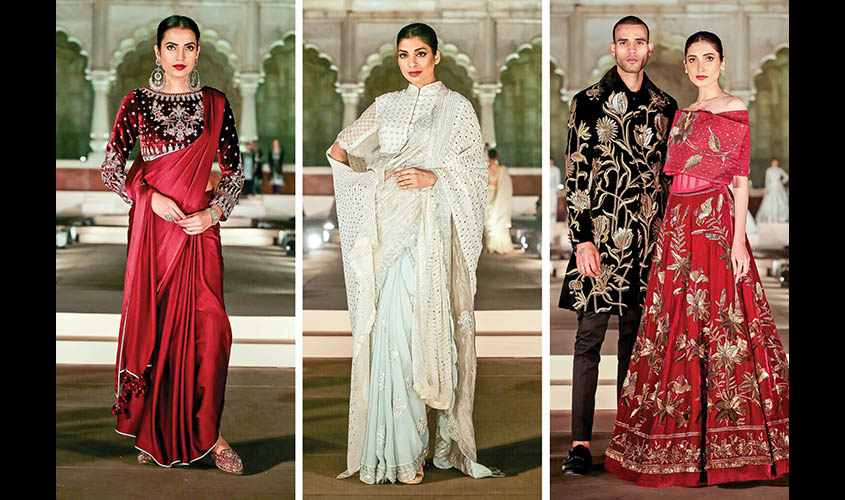On 5 January, the Ministry of Textiles and Fashion Design Council of India (FDCI) jointly organised “Artisan Speak”, a one-of-its-kind event that showcased India’s magnificent textile heritage and felicitated the people behind it. The event was held at the scenic Sawan Pavilion, Red Fort, Delhi.
The Union Minister for Textiles, Smriti Z. Irani, was present at the venue to honour the artisans with special recognition awards for their outstanding work in the textile sector. The minister handed out awards in various categories— such as technical textiles, silk and cotton among others—to seven individuals and one organisation.
FDCI president, Sunil Sethi, received a special recognition award for promoting handicraft and textile design. Sethi has spent over 30 years endorsing Indian handicrafts, textiles and fashion in both international and domestic markets.
Speaking to Guardian 20 about the event, Sethi said, “This was an evening of firsts—the first time that such an event was held in the surreal setting of Red Fort; the first time that we paid tribute to India’s top master weavers and crafts persons; and, most certainly, the first time that these artisans came together on a common platform with fashion designers and other creative individuals who have contributed so much to the textile industry. It was an honour for the FDCI to be associated with the Textile Ministry on Artisan Speak and to help organise an event of this nature.”
Another remarkable achievement award was presented to the textile designer and conservationist, Madhu Jain, for her work with natural fibres. She is credited with introducing India to bamboo fibre, an eco-friendly alternative textile, and developing the world’s first bamboo-silk ikat textile.
Talking about her work in promoting sustainable fashion, Jain said, “Being acutely conscious of environmental concerns, I’ve always been actively involved in developing sustainable, alternative textiles. With India being the second largest producer of bamboo in the world, I recognised early that India is well positioned to grab ascendancy in bamboo-yarn production. My dream is to help India realise that.”
The minister also honoured 13 master artisans for their dedication and unparalleled contribution to the handloom industry. The list included six Padma Shri awardees and seven winners of the Sant Kabir Award.

Padma Shri awardee Ramkishore Chippa Derawala is a master-artisan in traditional bagru and dabu hand block printing with natural dyes. By putting bagru and dabu prints on fabrics like Madhya Pradesh’s mulberry silk, Andhra khadi and Andhra mangalgiri, Derawala has breathed new life into these fabrics.
“Earlier,” said Derawala, “we were confined to just three to four colours like indigo blue or neela, yellow and maroon were only used for women’s lehengas. Today the craft has not only spread to saris and salwar kameez, but a new colour palette too has emerged based on experiments which have introduced vibrant new vegetable dyes. Colour, usage and designs have changed in our craft, but the spirit remains the same.”
Another master weaver and designer recognised at the event was Gajam Anjaiah. He is widely known for his innovations in ikat and his work with Telia Rumal. Anjaiah received the “Master Artisans Honoured Award” for his contribution and work in the Indian textile sector. He has also worked on Kanjeevaram saris for designer Gaurang Shah.
Anjaiah spoke to Guardian 20 about
About his contribution to the traditional art of weaving, he said, “I had trained around 40 weavers in Chandur village in Nalgonda district and 20 weavers in Amangal village in Mahboobnagar district in Gadwal in tie and dye application on fabrics and Kanjeevaram, Uppada and Kota sari production.”
Devji Premji Vankar, from Bhuj in Gujarat, was another weaver who was awarded at the Red Fort event. A specialist in fine shawl work, Vankar said, “Gujarat shawls are the best when compared to the shawls made in other parts the country. In our shawls, made in Kutch, there is an extra dhaaga [thread] in the warp and weft. And this gives an edge to our final product.” His major contribution has been the use of fine quality yarns to create soft fabrics in traditional Kutch weaving technique.
The event was followed by a well choreographed fashion show of saris and outfits created by India’s top six designers, namely Anita Dongre, Anju Modi, Rahul Mishra, Rajesh Pratap Singh, Gaurang Shah and Rohit Bal.
Gaurang Shah showcased his exquisite Jamdani sari designs on the ramp at the gala night. He said, “Indian Jamdani weaving has evolved magnificently over the years. Two decades ago the weaving community had boring floral designs, colours and yarns. Textile designers like me along with my team of weavers across the nation consciously brought back the korvai weaving technique in pure zari, elaborate temple designs and traditional designs with borders as huge as 20 inches.”
He also highlighted the importance of supporting Indian artisans through state grants and special events. “Events like Artisan Speak backed by the Ministry of Textiles and FDCI help to showcase the diversity and enhance the appeal of our artisans’ work to a wider, global audience,” Shah said.

